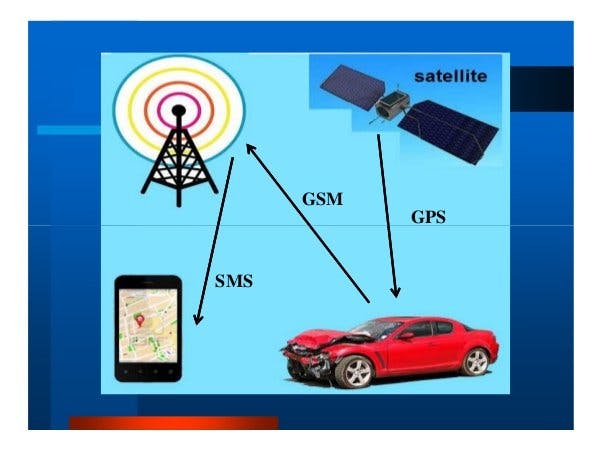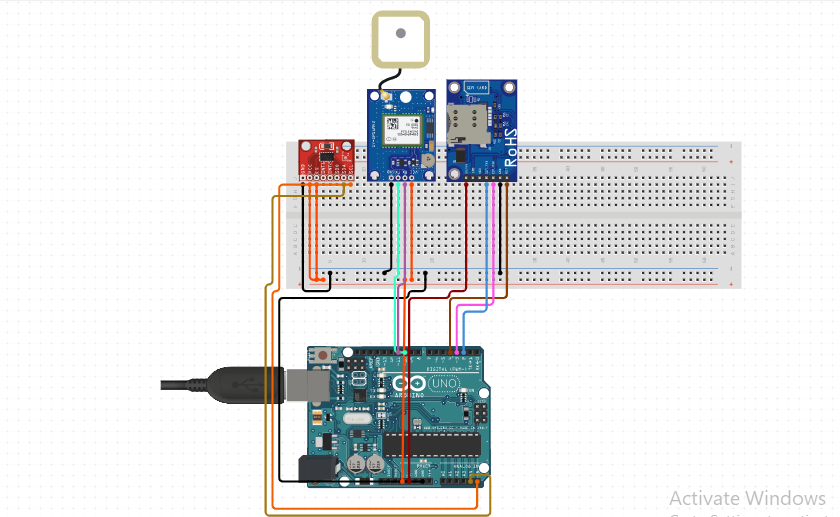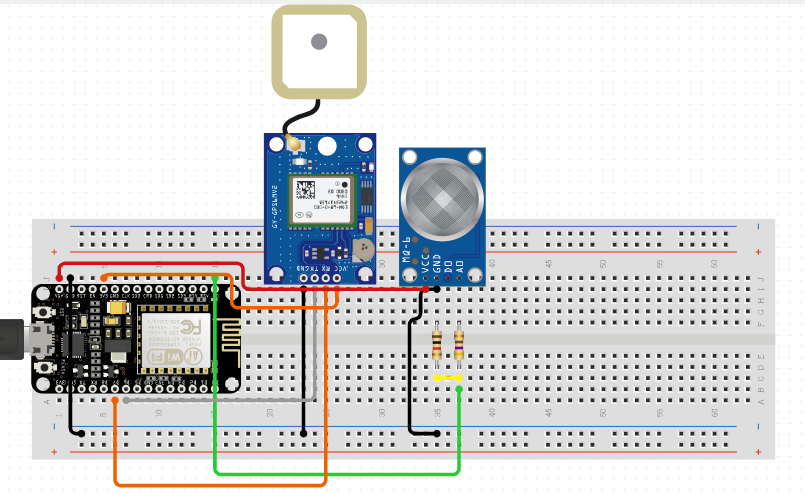Hardware components | ||||||
_ztBMuBhMHo.jpg?auto=compress%2Cformat&w=48&h=48&fit=fill&bg=ffffff) |
| × | 1 | |||
 |
| × | 1 | |||
 |
| × | 1 | |||
 |
| × | 1 | |||
 |
| × | 1 | |||
Software apps and online services | ||||||
 |
| |||||
 |
| |||||
Every day around the world, a large percentage of people die from traffic accident injuries. An influential indicator of survival rates after detecting the accident is the time between the occurrence of the accident and the arrival of emergency responders to the scene. Reductions in this time, in turn, may affect the numbers of fatalities, and this is achieved through using automatic traffic accident detection and notification systems which are either built-in the modern vehicles or available in the roads. In this system, it detects whether accident occurs or not using accelerometer and it notifies to some numbers through call and then they check using blynk app where location will be traced. In addition to that whether any smoke or gas leakage also it detects and notifies through Blynk app.
#include "TinyGPS++.h"
#include "SoftwareSerial.h"
SoftwareSerial GPRS(2,3);
SoftwareSerial serial_connection(10, 11); //RX=pin 10, TX=pin 11
TinyGPSPlus gps;//This is the GPS object that will pretty much do all the grunt work with the NMEA data
float latitude=0;
float longitude=0;
String Speed="";
int Contrast=20;
#define x A1
#define y A2
#define z A3
int xsample=0;
int ysample=0;
int zsample=0;
#define samples 10
#define minVal -50
#define MaxVal 50
void setup()
{
Serial.begin(9600);//This opens up communications to the Serial monitor in the Arduino IDE
serial_connection.begin(9600);//This opens up communications to the GPS
Serial.println("successfully Initialized....");
Serial.println("GPS Start");//Just show to the monitor that the sketch has started
for(int i=0;i<samples;i++)
{
xsample+=analogRead(x);
ysample+=analogRead(y);
zsample+=analogRead(z);
}
xsample/=samples;
ysample/=samples;
zsample/=samples;
Serial.println(xsample);
Serial.println(ysample);
Serial.println(zsample);
delay(1000);
}
void loop()
{
while(serial_connection.available())//While there are characters to come from the GPS
{
gps.encode(serial_connection.read());//This feeds the serial NMEA data into the library one char at a time
//Serial.println("Satellite Count:");
}
if(gps.location.isUpdated())//This will pretty much be fired all the time anyway but will at least reduce it to only after a package of NMEA data comes in
{
//Get the latest info from the gps object which it derived from the data sent by the GPS unit
Serial.println("Satellite Count:");
Serial.println(gps.satellites.value());
Serial.prin tln("Latitude:");
Serial.println(gps.location.lat(), 6);
Serial.println("Longitude:");
Serial.println(gps.location.lng(), 6);
Serial.println("Speed MPH:");
Serial.println(gps.speed.mph());
Serial.println("Altitude Feet:");
Serial.println(gps.altitude.feet());
Serial.println("");
delay(1000);
}
int value1=analogRead(x);
int value2=analogRead(y);
int value3=analogRead(z);
int xValue=xsample-value1;
int yValue=ysample-value2;
int zValue=zsample-value3;
Serial.print("x=");
Serial.println(xValue);
Serial.print("y=");
Serial.println(yValue);
Serial.print("z=");
Serial.println(zValue);
delay(1000);
//condition for accident detection
if(xValue < minVal || xValue > MaxVal || yValue < minVal || yValue > MaxVal || zValue < minVal || zValue > MaxVal)
{//in case of accident calling to a number 5 times if needed we can add multiple numbers.
for(int i=0;i<5;i++)
{
Serial.println("calling");
GPRS.begin(9600);
Serial.println("Connecting to network");
delay(20000);
Serial.println("Should be connected to network by now");
GPRS.print("ATD+xxxxxxxxxxxx;\r");
Serial.println("Dialing");
delay(12000); //Give it time to connect
//GPRS.print("ATH\r"); // And disconnect
Serial.println("Disconnect");
}
}`
delay(1000);
}
tracking_accident_location
ArduinoConnecting nodemcu to wifi network and blynk app we can trace the location of person.
#define BLYNK_PRINT Serial
#include <ESP8266WiFi.h>
#include <BlynkSimpleEsp8266.h>
#include <TinyGPS++.h>
#include <SoftwareSerial.h>
static const int RXPin = 4, TXPin = 5; // GPIO 4=D2(conneect Tx of GPS) and GPIO 5=D1(Connect Rx of GPS
static const uint32_t GPSBaud = 9600;
char auth[] = "authentication key"; //Your Project authentication key
char ssid[] = "wifi id"; // Name of your network (HotSpot or Router name)
char pass[] = "wifi pwd"; // Corresponding Password
TinyGPSPlus gps; // The TinyGPS++ object
WidgetMap myMap(V0);
SoftwareSerial ss(RXPin, TXPin); // The serial connection to the GPS device
BlynkTimer timer;
int gas_value;
int gas_avalue;
float spd; //Variable to store the speed
float sats; //Variable to store no. of satellites response
String bearing;
unsigned int move_index = 1;
void setup()
{
pinMode(16, INPUT);
Serial.begin(9600);
ss.begin(GPSBaud);
Blynk.begin(auth, ssid, pass);
timer.setInterval(5000L, checkGPS);
}
void checkGPS(){
if (gps.charsProcessed() < 10)
{
Serial.println(F("No GPS detected: check wiring."));
//Blynk.virtualWrite(V4, "GPS ERROR"); // Value Display widget on V4 if GPS not detected
}
}
void loop()
{
gas_avalue = digitalRead(D3);
if (gas_avalue < 1)
{
Serial.println("DANGER!!!!");
digitalWrite(D4,HIGH);
Blynk.notify("gas and smoke alert");
}
else
{
Serial.println("NO LEAKAGE");
Blynk.notify("no leakage");
digitalWrite(D4,LOW);
}
delay(100);
while (ss.available() > 0)
{
// sketch displays information every time a new sentence is correctly encoded.
if (gps.encode(ss.read()))
displayInfo();
}
Blynk.run();
timer.run();
}
void displayInfo()
{
if (gps.location.isValid() )
{
float latitude = (gps.location.lat()); //Storing the Lat. and Lon.
float longitude = (gps.location.lng());
Serial.print("LAT: ");
Serial.println(latitude, 6); // float to x decimal places
Serial.print("LONG: ");
Serial.println(longitude, 6);
Blynk.virtualWrite(V1, String(latitude, 6));
Blynk.virtualWrite(V2, String(longitude, 6));
myMap.location(move_index, latitude, longitude, "GPS_Location");
spd = gps.speed.kmph(); //get speed
Blynk.virtualWrite(V3, spd);
sats = gps.satellites.value(); //get number of satellites
Blynk.virtualWrite(V4, sats);
bearing = TinyGPSPlus::cardinal(gps.course.value()); // get the direction
Blynk.virtualWrite(V5, bearing);
}
Serial.println();
}













Comments
Please log in or sign up to comment.